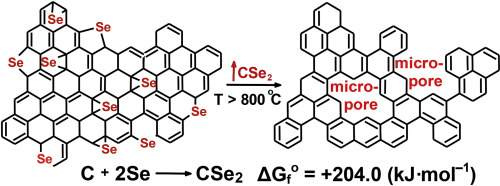Microporous and Mesoporous Materials ( IF 4.8 ) Pub Date : 2018-06-26 , DOI: 10.1016/j.micromeso.2018.06.047 Wojciech Kiciński , Bogusław Budner , Małgorzata Norek , Mateusz Szala , Marek Polański , Sławomir Dyjak

|
The outstanding properties of carbon materials doped with p-block elements are usually attributed directly to the presence of certain foreign atoms. By using the example of selenium-doped carbon gels, we hereby postulate that in many cases the properties of doped carbon materials are not determined by the presence of the heteroatom itself, but rather by how the element affects the carbon structure during high-temperature synthesis. Se-doped microporous carbogels were obtained via sol-gel polycondensation of resorcinol and 2-formylselenophene followed by pyrolysis at 600–1200 °C. Pyrolysis temperatures above 800 °C result in a decrease in the Se-content accompanied by a distinct increase in ultramicroporosity. A comparative analysis of oxygen-, sulfur- and selenium-doped carbogels shows that chalcogens increase the porosity of carbonaceous materials via the high-temperature oxidation of carbon to corresponding dichalcogenides (CO2, CS2 or CSe2), but their oxidative power diminishes with increasing atomic mass. Consequently, S and Se are more selective carbon oxidants.
中文翻译:

硫族元素掺杂的碳材料中的微孔起源:硒掺杂的碳凝胶的情况
掺杂有p嵌段元素的碳材料的出色性能通常直接归因于某些外来原子的存在。通过以硒掺杂的碳凝胶为例,我们据此推测在许多情况下,掺杂的碳材料的性能不是由杂原子本身的存在决定的,而是由元素在高温合成过程中如何影响碳结构决定的。硒掺杂的微孔碳凝胶通过间苯二酚和2-甲酰基硒基苯酚的溶胶-凝胶缩聚反应,然后在600–1200°C下热解。高于800°C的热解温度导致Se含量降低,同时超微孔率明显增加。氧,硫和硒掺杂的碳凝胶的比较分析表明,硫族元素通过碳高温氧化成相应的二卤代二硫化碳(CO 2,CS 2或CSe 2)来提高含碳材料的孔隙度,但其氧化能力却降低了。随着原子质量的增加。因此,S和Se是更具选择性的碳氧化剂。











































 京公网安备 11010802027423号
京公网安备 11010802027423号